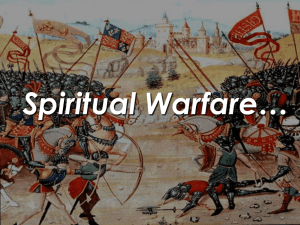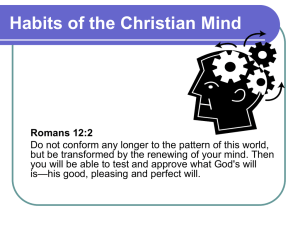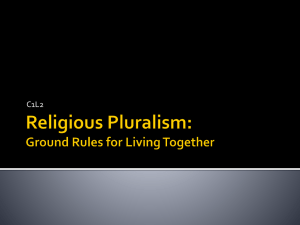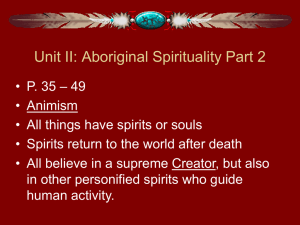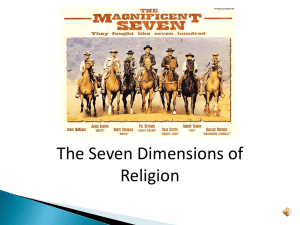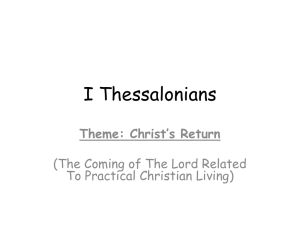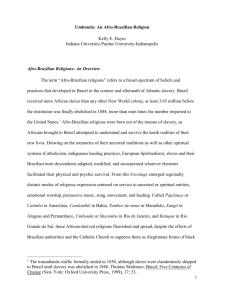An Introduction to the Study of Religion
advertisement
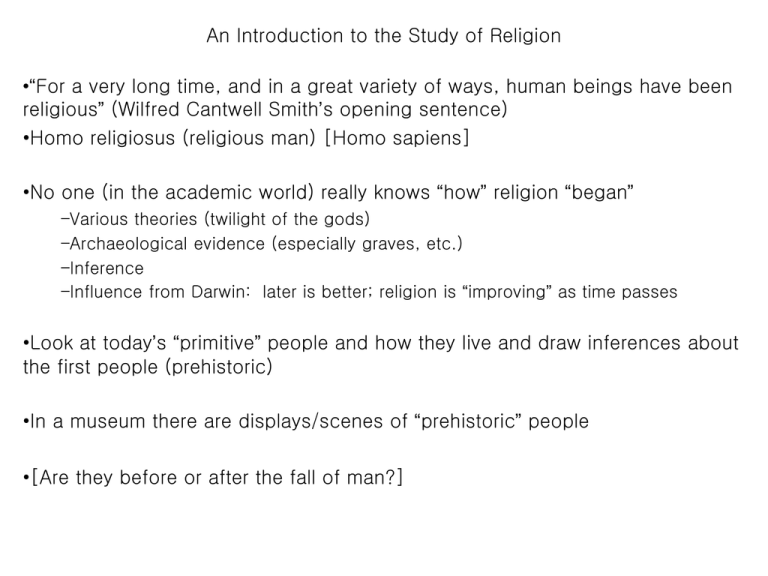
An Introduction to the Study of Religion •“For a very long time, and in a great variety of ways, human beings have been religious” (Wilfred Cantwell Smith’s opening sentence) •Homo religiosus (religious man) [Homo sapiens] •No one (in the academic world) really knows “how” religion “began” –Various theories (twilight of the gods) –Archaeological evidence (especially graves, etc.) –Inference –Influence from Darwin: later is better; religion is “improving” as time passes •Look at today’s “primitive” people and how they live and draw inferences about the first people (prehistoric) •In a museum there are displays/scenes of “prehistoric” people •[Are they before or after the fall of man?] What is the basic idea behind religion? Sunrise on Christology p 172-176 • quotes The Perspective of Divine Principle and Unification Thought: • UT – Law of Dominion of the Center (environment is prepared, then S is established) – Central Providence (Judeo-Christian tradition) and Peripheral Providence (the other world religions) • p 327 D Pr preparation for the First Coming – Among the world’s peoples, God founded religions (or philosophies) suited to their regions and cultures by which they could make the necessary internal preparations to receive the Messiah • In India, Buddhism through Gautama Buddha (565-485 BC) • In Greece, Socrates (470-399 BC) • In the Far East, Confucianism through Confucius (552-479 BC) • Also Tao Te Ching, Mahavira, Upanishads, Zoroaster, Hebrew Prophets, Pythagoras, Socrates, Aristotle, Plato • All these roughly 400-500 years before Christ The Axial Age John Hick (God Has Many Names) 45-6 In what Karl Jaspers has identified as the axial period or axial age, from approximately 800 to approximately 200 BC, significant human individuals appeared through whose free responses to the Eternal One—though always within the existing setting of their own cultures— man’s awareness of the divine was immensely enlarged and developed. Thus, the axial age was a uniquely significant band of time in man’s religious history. • One can say that in this period all the major religious options (the different forms of our awareness of God) were identified and established. • What is the inner (genuine) significance of these various religions? – God is preparing the world to receive the Messiah (Jesus the Christ) p 178 Sunrise on Christology • If Jesus had not been crucified…. • Jesus would have gone to India, China and the Orient, and then to the Western world. • What would he have encountered? – Jesus would have encountered teachings which believed in spiritual teachers and individuals who “descend from the gods,” teachings which emphasize inner purity of thought, etc. and which were more into the human spirit, heart, and purity than into textual authority – [In Israel, Jesus, who gave the impression of a “street person” in reality encountered a religious leadership (Pharisees, Saducees, etc.) which expected “Elijah” first, before the Messiah, and which regarded him as a heretic, a blasphemer, a liar, and a dangerous charlatan, who used the power of the Devil, all based upon their strict textual authority & interpretation of their Scripture (Torah)] – Jesus was to come upon the worldwide foundation of preparation, and through his teaching was to unify all religions and civilizations into one. • Buddhism (Dhammapada) • Hinduism (Bhagavad Gita) • Confucianism (Analects of Confucius) • These Scriptures all are resonant with Jesus’ teachings • He would have been seen as an avatar by Hindus, the Maitreya Buddha by Buddhists, the New Confucius by Confucians, etc. DPr 104 • God helps ignorant, fallen people to elevate their spirituality and enlighten their intellect through spirit and truth • In the course of history, people’s spiritual and intellectual levels have gradually been elevated • Spirit and truth are unique, eternal and unchanging. However, the degree and scope of their teaching and the means of their expression will vary from one age to another as they restore humanity from a state of utter ignorance. • • • • • “Jesus” himself was the way, the truth and the life (and the love, SMM), not his words. His words were just the means by which he expressed himself. Thus, the scope and depth of his words, and his teaching method varied according to whom he was speaking The bible literally is simply paper and ink (just as any scripture text) The verses in the Bible which express information (truth) are only one means of expressing the truth, and are not the truth itself. We are to embody the word of God, just as Adam and Eve were meant to (FF: believe; FS: embody) Other scriptures (Dhammapada, Lotus Sutra, Vedas, Bhagavad Gita, Koran, Analects, Adi Granth, etc.) also express the truth, directly or indirectly, but with a different scope, depth, and/or means of expression • p 96 Divine Principle: Signs of the restoration of the 3 great blessings in the Last Days • Huston Smith “Accents of the World’s Religions” – India: psychological aspect = first blessing – Far Eastern: social aspect = second blessing – Western: nature, natural = third blessing “Inescapably, a person is involved in three basic encounters: with nature, with other people, and with him/herself. These may be identified as humanity’s natural, social, and psychological problems. The great surviving cultural traditions are also three: The Far Eastern, the Indian, and the Western. We can think of each as having attended to one problem more diligently than to the other two. Specifically, the religions of the West (Judaism, Christianity, and Islam) have accented the problem of humanity’s relationship to nature; those of the Far East (Confucianism, Taoism, and Shinto) have stressed its social problem; and those of India (Hinduism, Buddhism, Jainism) have attended primarily to its psychological problem, What gave these traditions their distinctive slants or perspectives? [probably God, Who, in His wisdom, gave to each culture the religion suitable to its needs, mission, capacity, etc.] This question probably does not have a complete answer. p 136 In the end all three traditions are brought to the brink of disaster because each has succeeded so well on one front that it felt safe in neglecting the other two. [the three blessings must be fulfilled together; fulfillment of the 3 blessings will bring all the religions together] p 138 It would appear that an adequate culture must strike all three notes as a chord. In developing this chord of a fully adequate world culture, each of the three great traditions appears to have something of importance to contribute. Perhaps each has something to learn as well. Ewert H. Cousins (“Interreligious Dialogue: The Spiritual Journey of Our Time”) • • • Individuals today have embarked upon a spiritual journey: the common, collective spiritual journey of the human community as we approach the 21st century (we are now in the 21st century). This is a journey that opens up through interreligious dialogue Interreligious dialogue is the distinctive spiritual journey of our time Interreligious Dynamics (together with the “Dialogue Decalogue”): • Must take place on a deep, spiritual level (sharing from the heart, solidly rooted, supported by wisdom) • “Passing over and coming back” • We will find similarities, as well as differences (challenging, but creative) • We will find ourselves being drawn to an emerging global consciousness • To understand this global consciousness, situate interreligious dialogue in a larger context • Look us look to another great transitional period: the Axial Period (which we just noted) Karl Jaspers • “It would seem that this axis of history is to be found in the period around 500 BC, in the spiritual process that occurred between 800 and 200 BC. It is here that we meet with the most deep cut dividing line in history. Man, as we know him today, came into being. For short we may style this the “Axial Period.” • “In the Axial Period there emerged great spiritual leaders, prophets and philosophers, whose teachings represent a change from mythic to selfreflective thinking, from union with the cosmos and the tribe to individual identity which stands apart from nature and collectivity.” • “In this age were born the fundamental categories within which we still think today, and the beginnings of the world religions, by which human beings still live, were created.” Karl Jaspers • “I believe that we are now going through a Second Axial Period, which will be as momentous as the First. While the First Axial Period produced individual consciousness, the Second Axial Period is producing global consciousness.” • The complex consciousness of the Second Axial Period is global in two senses: – In a horizontal sense it is encompassing the entire human community on the planet in all of its historical experience [we are to become one family, heartistically] – In a vertical sense it is recovering its rootedness in the earth. The religions of the world must recognize the value of the secular—the political, economic, social and biological dimensions of life; but this secular energy must be grounded in spiritual energy so that it will not become chaotic and destroy life on our planet. [we must restore society (the world) in a real sense: the politics, economics, media, education, etc.] • In such a global context, interreligious dialogue is not a luxury, but a necessity! Can We Know the Religious Faith of Others? To know the religious faith of others is to understand the existential interpretations of a tradition. • We cannot be an “observer,” but must be a “participant” (Hyung Jin Nim!) • The existentialist dilemma: you cannot know before you leap, and you find it hard to leap before you know. • The participant can see very clearly that the outsider may know all about a religious system, and yet may totally miss the point. • From what can faith be inferred? Not from a doctrine, or from a book, but from the whole of the believer’s life • Even a believer’s own words cannot fully or adequately formulate his/her faith. The intensely personal quality of life is not open to literal representation. A faith cannot adequately be expressed in words, not even by a person who holds it devoutly. • • Friendship can begin to enable an enquirer to directly intuit the quality and depth of personal faith. There is a relationship between a person’s own personal faith and his/her understanding of the religious life of other people. • My capacity to apprehend significantly and truly the religious stand of other individuals turns in part on the understanding that I bring to it—the religious understanding, in short, my own faith. [cf Subjective action in UT] • The fact of my being a Christian is relevant to my understanding the faith of Hindus, Buddhists, Muslims, and the like. • The fact of my being a Unificationist is relevant to my understanding the faith of Hindus, Buddhists, Muslims, and the like. • Sunrise on Christology – – – – • p p p p 197 200 200 200 We must know the essence of every religion A life lived with true love… Can you ask all believers…. Become a true believer… Of course, the spirit world will help us, if we can mobilize it. True Father has told us that we must know the Spirit World! We shall be able to grasp another’s faith only to the extent that we possess the appropriate subjective condition that equips us for this task. And what is this condition? It is that we should ourselves possess a personal faith that resembles the quality of the faith we seek to understand. We are able to grasp the faith of another only to the extent that we share it. A secularist, secular humanist, atheist, etc. cannot understand someone’s faith. Now, with all of these considerations in mind • The basic idea behind religion • The impending second axial period • The fact that all religions must participate/cooperate in creating the new world • That interreligious dialogue is a necessity for our time • That we can know the faith of another only if we possess a personal faith of an equivalent level • That we must become a better believer than any believer of any religion • And that we need to mobilize the spirit world to help us….let us turn to examine the various religious traditions that have existed in the past, and those which exist today Prehistoric Religion (millions of years ago) • • • God’s Will & the World (“millions” of years ago) [p 363; 404; 445] 천성경 too Neanderthal man – Graves: evidence of belief in an afterlife – Placement of the body; use of “red ochre” coloring Cro-Magnon man (Upper Paleolithic age): hunting and fishing – Cave paintings (magico-religious function); importance of “magic” • Everyday life was lived just inside of caves • Paintings are in inaccessible places deep in the confines of a cave • • Realistic animals (these were their livelihood) • Unrealistic human figures (of much less importance) – The shaman of Les Trois Freres (a special costume) – Venus of Willendorf (emphasis on productivity, fecundity, fertility) Neolithic age; agriculture becomes important – Dolmens (such as are found in Korea) – Cromlechs (Stonehenge, in England) Some characteristics of “primal” religion today • • • • • • Primitive society is “static” and resists change Awe before the sacred (an emotional world, pre-scientific, the “unknown”) – Niagara Falls, a bolt of lightning, a herd of buffalo, etc. Expression of anxiety in ritual (to appease the powers that be) – Like a small child afraid of the dark Ritual and expectancy [“ritual” is very real and very serious] “charter” Myth and ritual (and symbol) – Explain and give weight to the supernatural origin and authority of the community’s customs, ceremonies and beliefs – Origin of important things in life (food, water, etc.) Bi-polarity of religion and magic – Magic: an endeavor through utterance of set words, or performance of set acts, or both, to control or bend the powers of the world to human will. – Types of magic: • Sympathetic magic (law of sympathy) – Homeopathic magic or “imitative magic” (law of similarity) “like influences or produces like” [“draw a picture here, make it happen out there”] (i.e. Gen 30: 37-42) – Contagious magic (law of contact): contact; obtain a strand of hair (which “becomes” the whole person) and set it on fire • • • Prayer (petitionary) and spells (coercive) Divination (there are “signs,” if you can see them) Belief in mana (a force) [often associated with taboo – Father’s “mana” GsWW, 407 GsWW – Resembles “electricity” (neither good nor evil, but it can do things) • Animism (spirits are “everywhere”) – It is not a “dead” universe (Newton’s universe = machine) • • • Veneration and worship of powers (powers we don’t understand) Recognition of high gods Taboo (a danger) [often associated with mana]; an “insulator” – Forbidden by convention, not by statute • (i.e. II Sam 6:1-7) Purification rites (when one does make a mistake) – Sources of pollution: birth, death, blood, menstruation, disease, etc. • • • Sacrifice Attitudes toward the dead (a great “unknown”) Totemism (identification with nature) • There are some residual holdovers affecting us even today – Do we carry True Father’s picture, UC flag, etc.? Dimensions of religion • Religious traditions possess a variety of dimensions: – Doctrinal (dogmas, conceptual, intellectual, beliefs) • Truth claims • Inter-religious dialogue – Mythical (universal myths, stories “of the gods”) • Myths exist in every culture (Joseph Campbell: Hero with a Thousand Faces) • Garden of Eden story in Genesis (this is “myth”): not scientific – Ritual/liturgical (liturgical calendar) • Sacred vs mundane • Sacred time/sacred space • Unification Pledge service (안시일) – Communal/sociological (community of faith; set apart) – Ethical/moral (do’s and don’ts of life; standards of right/wrong, good/evil) • Dae Mo Nim: do not smoke, drink, or take drugs; never fall (don’t look, touch, etc.) – Aesthetic (art and architecture) • • • • Paintings (Buddhist, Sistine chapel, Michelangelo, etc.) Statues (Maitreya Buddha, Hindu gods and goddesses, etc.) Buildings (temples, churches, cathedrals, etc.) Writings (Scriptures, Calligraphy, koan, etc.) Classification of religions • No single method – – – – – – • Linear and cyclical Personal and impersonal Monotheistic, polytheistic (henotheism, kathenotheism) Chronological appearance Textual and non-textual Individual and communal God’s Will and the World – True Father’s classification (p 554f) • • • • • • Primal (ancient, Shamanism) Indian religions (Hinduism, Jainism, Buddhism, Sikhism) Japanese (Shinto) Chinese (Taoism, Confucianism) Semitic (Zoroastrianism, Judaism, Christianity, Islam) Native American, African Traditional Categories for the study of world religions • In our study of each tradition or path, we will consider: – View of God/Ultimate Reality – View of reality/the cosmos/nature of the universe – View of the human being – View of the human problem (fall, ignorance, illusion, sin, etc.) – View of salvation/liberation/enlightenment/healing – View of conduct (what is the correct conduct leading to enlightenment?) – View of history (linear, cyclical, etc.) – View of art (statues, temples, scriptures, paintings, etc.) – Providential role/situation/mission/importance, etc. The Origin and Purpose of Religion • God’s Will and the World – The origin and purpose of religion: – Sunlight on Christology, p 172- • Religion is – a mending process – an interim tool – to help us dominate the body and free the mind (conscience) • “If you are living with true love, then you have already achieved the highest goal of any religion.” (GsWW, p. 635) Shamanism • • • • • An archaic religion – Found in earliest cultures worldwide (medicine man, witchdoctor, etc.) – Apparently “inherent” in human nature itself (not produced by “culture”) The shaman “specializes in techniques of (achieving) ecstasy” – Can deliberately enter into states of trance (at will) – Transcending the normal, mundane, everyday consciousness – The shaman is a “specialist” in the human soul Three level universe – Upper, middle, lower – Cosmic mountain, world tree, tree of life, cosmic pillar, ladder, arrows, Jacob’s ladder, rainbow, bridge, river, cord, etc. – Unlike most people, the shaman can freely travel in all spheres – Supernatural abilities, mastery of fire, “flight,” immune to injury, etc. The shaman controls the spirit world & the spirits (can leave body or be “possessed”) – The SW is hierarchically organized, with four quadrants, numerous spirits – There are spirits everywhere, constantly affecting human beings – Has learned its secrets, often through a symbolic “death and dismemberment” – Has cured himself, and thus has the knowledge of the spirits The shaman protects the psychic integrity of the community (신병: spirit sickness) – Can discover the (spiritual) source of problems and, more importantly, give solutions Shamanism in Korea • • • • Has existed throughout Korean history – From Neolithic times: Tangun was the first shaman (Paektu-san) – Shamanism (2333 BC), Buddhism, Confucianism, Christianity, present (2007) – Queen Min brought her favorit manshin into the palace – 1992: McAlpine: early revival of the stock market A full appreciation of Korean culture requires an understanding of shamanism (i.e., 10 symbols of longevity; piles of rock on trails; ribbons on trees, gold Shilla crown, etc.) Mutang (woman), manshin (powerful), paksoo (man), pansoo, etc. – In Korea a transformation from a male-dominated activity to a female-dominated activity – Lowest on the social totem pole – Most sought after in times of difficulty (it fulfills practical human needs) 만신 (만세! = 10,000 years;) 만신 = 10,000 (i.e., all) spirits – There are both good and evil spirits – The most vicious evil spirits are spirits of those who die with grievances (“han”) – They can become good or bad depending on how they are served • Manshins are family shamans or professional shamans – Professional shamans become so through • Heredity • Training [least powerful] • Spirit-appointed (these have had spiritual experiences) [most powerful] • Calling and initiation of a woman as a shaman – Revelation experience comes with a mysterious untreatable illness (no doctor can cure it) – Dream-like state, no appetite, sickly, dreams, has illusions, weak memory, feels pain in her limbs, etc.) – Only a positive response to the “calling” can bring a “cure” – Becomes an apprentice in training (under a mentor) • Must learn many things (chants, dances, rituals, etc.) • – Initiation ritual (내림긋); she becomes a “god-descended person” (내림사람) – The spirit will come, will speak, will act, etc. (양/음) The kut ceremony (the ritual drama of the séance) – Main ritual; usually at night (a greater 긋 has a number of 고리 or 고사) – Calling the god; amusing the god (purpose, prayer, chants, dances, music, props and costume); sending the go – Can last from a few hours to several days; usually in stages – Offerings, music, dancing, drama, chanting, acrobatics, theater, etc. – Therapeutic significance; psychogenic and psychosomatic problems Kut (긋) Ceremony • • • • Kut ceremony has many varieties (many purposes): practical advantage – New year; before a trip; before a new job; when a new house is built; to pray for a baby, for marriage, when there is a problem of any kind (disease, accident, bad grade, etc.); performed on a boat; for when the head of household is 27, 37, 47, 57, 67, and 77 years old; performed for a good crop, etc. – A most representative 긋 ritual is to pray for the realization of wishes – The ceremony is very colorful, kinetic, musical, dramatic, and entertaining A 긋 ceremony usually has an offering table and involves dancing, etc. Manshin must learn the choreography, chants, etc. of each 긋 – Certain equipment is used: fans, swords, drums, bells, mirrors, trident, costumes – Costumes are symbolic (it transubstantiates the manshin) – The shamanistic deities are usually depicted on the fans Care and feeding of ancestors (becomes quite complex) – Both relationships through marriage and through birth – Ancestors, generational relationships, different households, etc. (chart) • A manshin may have many clients (must know many details about her clients) – Not all manshins are of equal power – Effective manshins will have more clients; greater reputation • A powerful manshin dreams of her clients and anticipates their questions before they enter her house • She knows all of the ancestors, ghosts, and gods of her clients’ families • • – The “sidewalk variety” (fortune tellers) A manshin has extraordinary energy, mental acuity, sensitivity Prior purification is necessary for a successful 긋 ritual – If any pollution, could be extremely injurious • Someone with a wrong motivation • Someone who is skeptical, etc. • Someone impure • God: A whole pantheon of gods and goddesses – – – – • • • • Hananim; O Pang Chang Koon (five divine generals) Old man of the mountain (often seen with a tiger) Four quadrants of the cosmos and the apex Spirits of the air, water, soil, trees, rocks, house, etc. Reality: three story universe (upper world, this world, lower realms) Human being: body and spirit (actually several layers of spirit) Human problem: out of harmony with people, ancestors, and the spirits Human salvation: a “here and now salvation,” on the earth, in this lifetime – Keep harmony with ancestors, people, and spirits – A good long, healthy, productive, prosperous life with many male children • • • Human conduct: maintain harmony all around oneself History is cyclical; no view of an end or “consummation” or “eschaton” Considerable religious art, expression of the spirit – The gold Silla Dynasty crowns (cosmic tree and reindeer antlers) – The 10 Symbols of longevity (folding screen) [turtles, deer, cranes, pines, bamboo, sun, clouds, rocks, water, magic puloch’o fungus) Unification 1. God’s truth is fully expressed Shamanism 1. Partial truth 2. Purpose of creation is made very clear 2. No clear purpose of creation 3. The SW is understood in context 3. The SW is dealt with as such and as experienced a. it is real b. suffering opens one 4. Messiah/True Parents; spiritualistis 4. Shamans (manshins, etc.) (spiritualists) 5. Actions - bring benefit in this world, here and now 5. Actions - benefit one in eternity Both traditions include: ritual and ceremony; both traditions involve cultural influences and conditioning; both traditions have diverse expressions Shamanism can only give temporary comfort or reduce the problem temporarily. It cannot solve a problem fundamentally. Unification can give a fundamental solution.
